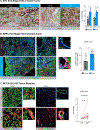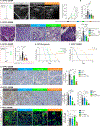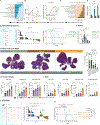Stromal reprogramming overcomes resistance to RAS-MAPK inhibition to improve pancreas cancer responses to cytotoxic and immune therapy
- PMID: 39441902
- PMCID: PMC12376167
- DOI: 10.1126/scitranslmed.ado2402
Stromal reprogramming overcomes resistance to RAS-MAPK inhibition to improve pancreas cancer responses to cytotoxic and immune therapy
Abstract
Pancreatic ductal adenocarcinoma (PDAC) is a lethal malignancy that is often resistant to therapy. An immune suppressive tumor microenvironment (TME) and oncogenic mutations in KRAS have both been implicated as drivers of resistance to therapy. Mitogen-activated protein kinase (MAPK) inhibition has not yet shown clinical efficacy, likely because of rapid acquisition of tumor-intrinsic resistance. However, the unique PDAC TME may also be a driver of resistance. We found that long-term focal adhesion kinase (FAK) inhibitor treatment led to hyperactivation of the RAS/MAPK pathway in PDAC cells in mouse models and tissues from patients with PDAC. Concomitant inhibition of both FAK (with VS-4718) and rapidly accelerated fibrosarcoma and MAPK kinase (RAF-MEK) (with avutometinib) induced tumor growth inhibition and increased survival across multiple PDAC mouse models. In the TME, cancer-associated fibroblasts (CAFs) impaired the down-regulation of MYC by RAF-MEK inhibition in PDAC cells, resulting in resistance. By contrast, FAK inhibition reprogramed CAFs to suppress the production of FGF1, which can drive resistance to RAF-MEK inhibition. The addition of chemotherapy to combined FAK and RAF-MEK inhibition led to tumor regression, a decrease in liver metastasis, and improved survival in KRAS-driven PDAC mouse models. Combination of FAK and RAF-MEK inhibition alone improved antitumor immunity and priming of T cell responses in response to chemotherapy. These findings provided the rationale for an ongoing clinical trial evaluating the efficacy of avutometinib and defactinib in combination with gemcitabine and nab-paclitaxel in patients with PDAC and may suggest further paths for combined stromal and tumor-targeting therapies.
Conflict of interest statement
Competing interests
D.G.D. is on the scientific advisory board for Adhaere, 149. Bio, and Gossamer Bio. R.E.O., S.C. and J.A.P. are employees from Verastem Oncology.
Figures






References
-
- Siegel RL, Miller KD, Fuchs HE, Jemal A, Cancer statistics, 2022. CA Cancer J Clin 72, 7–33 (2022). - PubMed
-
- Hosein AN, Dougan SK, Aguirre AJ, Maitra A, Translational advances in pancreatic ductal adenocarcinoma therapy. Nat Cancer 3, 272–286 (2022). - PubMed
-
- Mahadevan KK, McAndrews KM, LeBleu VS, Yang S, Lyu H, Li B, Sockwell AM, Kirtley ML, Morse SJ, Moreno Diaz BA, Kim MP, Feng N, Lopez AM, Guerrero PA, Paradiso F, Sugimoto H, Arian KA, Ying H, Barekatain Y, Sthanam LK, Kelly PJ, Maitra A, Heffernan TP, Kalluri R, KRAS(G12D) inhibition reprograms the microenvironment of early and advanced pancreatic cancer to promote FAS-mediated killing by CD8(+) T cells. Cancer Cell 41, 1606–1620 e1608 (2023). - PMC - PubMed
Publication types
MeSH terms
Substances
Grants and funding
LinkOut - more resources
Full Text Sources
Medical
Molecular Biology Databases
Research Materials
Miscellaneous

